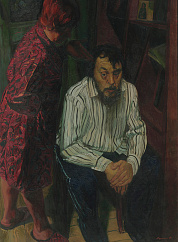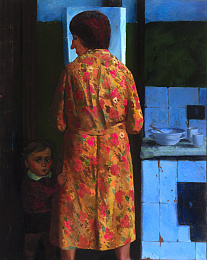Being fascinated by painting and given the ability to see things invisible to the others, artist is akin to a visionist. The nature of such penetrating vision implies the disintegration of cause-and-effect relations: subject is no longer just an image-symbol, fixed in language and consciousness; it transforms into something else. The years of apprenticeship and creative experience testify that Dmitry Margolin have mastered all the technical intricacies to perfection. Nevertheless he chooses to follow the path of simplifying his artistic language.
The paintings by Dmitry Margolin reflect the eternal dialogue of artist and tradition. The author deliberately ignores to talk about the crisis of fine arts and to express innovative maxims about the burden of traditions, considering such declamations nothing more but fashion. For him painting is rather the good, giving the joy of understanding; and the dialogue with the tradition is a mystical process allowing the artist to feel spiritual kinship with the long left masters of this world.
The very nature of Margolin’s painting is consonant with the ideas of expressionists. According to the author, he was brought to such archetypal images and eternal subjects as Oedipus or Job by something irrational. The creative process for Margolin is associated with persecution of certain inexplicable impulses. The artist depicts not what he sees or the cultural memory dictates, but such subtle impressions as a familiar smell from the childhood or an intense color experience. Thus he tightly shuts his studio door for the audience: this creative kitchen cannot be described in words. The comparison with culinary is more than appropriate: Margolin admits that painting resembles cooking — prosecution and embodiment of a certain taste idea. Indeed, when looking at the lines of Margolin’s etchings or when studying the texture of his paintings there comes a feeling of a very sensual nature of these works. Even the fundamental function of art as a means of self-knowledge and learning the world he finds illusory and inapplicable to reality.
Margolin percepts creativity as a way to achieve freedom. What kind of freedom exactly, is not quite clear, but to the question whether painting is one of the passions, Margolin answers affirmatively with no hesitation: “Yes. Perhaps, I'm obsessed. Hence, my freedom is out of the question”.
And there are plenty of such contradictions, which being born from the life experience, saturate his works with existential pathos, ultimate emotionality and sensuality. These artworks of spirit can be understood only through the eternal mythological subjects.
show

 Elizabeth2012
Elizabeth2012

